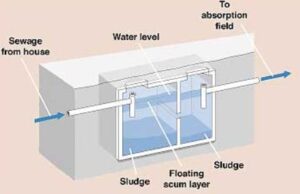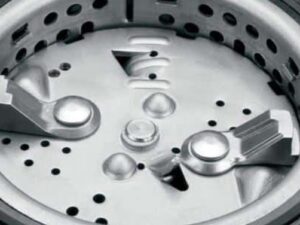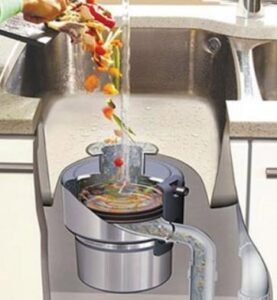There is no denying that garbage disposal can be a daunting task. It could only get worse if you do not have the right disposal mechanisms. Can you have a garbage disposal with a septic tank? Yes! Unless you have a reliable garbage disposal tin, you will barely have the convenience you envision. Here are a few insights into what a great option for you would be with a septic tank.
Can you have a garbage disposal with a septic system?
Yes. There is no denying that you can have a garbage disposal with a septic tank. Usually, the garbage disposal tends to release solids in the septic tank, allowing them to get drained. However, it would be best if you were relatively careful when using this setup. That is because there can be a significant increase of solids in the septic tank. This could result in clogging if not handled properly.
What does garbage disposal do?
A garbage disposal tool is a device or a container attached to the underside of the sink. It is designed to collect food waste and garbage in the grinding chamber. Once you turn on this disposal, a spinning disc turns rapidly, forcing the garbage against this chamber’s outer wall. With this, the waste gets pulverized into tiny bits, making it easier to wash down the chamber.
Typically, these devices:
- An alternative to trash cans
- Help divert food waste from landfills
- Straightforward to operate, maintain, and set up
These disposals have two blunt teeth, often called impellers. The teeth are on the impeller plate, and they are barely sharp. However, you cannot overlook their power to grind food waste.
The dishwasher water runs through the chamber, ensuring that large particles are ground before reaching the drain pipe.
However, it will be valuable for you to understand what and what not to put in the garbage disposal. It ensures that you do not clog your device, cushioning you against unwanted expenses. Often, it will be best to put in food waste only. The items need to be relatively easy to crash and dispose of.
Typically, you need to know the parts of the garbage disposal. It will ensure that you understand how the entire system operates.
Usually, the sink comes with rubber flaps around its sides called splash guards. These flaps ensure that the crashed food does not splash back into the sink basin. It is also the place where you will place food scraps into the disposal.
There is also an upper hopper, which ensures that running the garbage disposal with water becomes seamless. This part comes with the flywheel and the shredder ring. The shredder is a stationary piece of metal, and it has teeth. The flywheel entails impellers on its two sides, which ensure unrivaled efficiency.
What does a septic system do?
Septic systems are underground treatment structures that have no centralized sewer systems. It relies on both nature and reliable technology to treat this wastewater. Whether it is from the bathroom, laundry, or kitchen drains, you will be sure of a similar experience at all times. In most cases, this system entails a septic tank and a drain field.
You can barely overlook the significance of the septic tank. It helps digest different organic matter and even separates floatable matter. The system then discharges the effluent from the septic tank to various perforated pipes in a leach field. That means the waste automatically goes into the soil.
Some systems might use pumps to help the septic tank effluent trickle through the sand. They could also help neutralize or remove various pollutants, ensuring that the environment remains safe. Further, alternative systems can come in handy in evaporating wastewater and disinfecting it before getting discharged into the soil.
This system provides an excellent alternative to shared sewer systems. Here is how this system ideally works:
- All the wastewater in your house runs through one drain pipe to the septic tank.
- The septic tank holds the waste for long enough to allow any solids to settle down, forming a sludge. The oils remain on top, creating scum.
- The effluent gets out of the tank and into the drain field.
- The wastewater percolates into the soil.
What is the best garbage disposal for a septic system?

Various aspects go into the selection of the right garbage disposal for your septic system. Ensure that you consider the following variables when selecting one.
1. Choose the right type
Garbage disposals come in two categories, including batch-feed and continuous-feed models. Continuous-feed garbage disposal allows you to throw food when still running, assuring you of unrivaled convenience. They are not only popular but also relatively budget-friendly. In contrast, batch-feed models allow you to insert food waste in batches, helping reduce injury risks. However, they are costlier.
2. Determine the power
Garbage disposals use different amounts of power, and understanding how much each will consume should be the first step. In most cases, the horsepower will lie between 1/3 and 1. An increase in the horsepower assures you of better efficiency and sound insulation. On the other hand, smaller machines might not handle heavy-duty use properly. Experts suggest ½ and ¾ HP for typical families.
3. Decide on the size
Deciding on the right size can be a relatively daunting task for most people, as it entails multiple variables. Usually, you will need to observe the household size, the food you grind, and the cooking frequency. You will also need to know the right motor size for your disposal. For instance, if you have a family of over four and cook daily, you need a 1 HP motor. If the family has 2-4 people, a ¾ HP will be enough for you.
4. Accessories
Accessories come in handy in ensuring that you have an easier time in the long run. Now would be the right time to confirm if the device has a reliable power cord. It would often help if you had a long cord, as it allows you to place the device anywhere. Some of these disposals come with no power cord, exposing you to a further $15 expense.
5. Operation
Ensure that you understand how the device operates. It would be best to choose a device that has multiple grind stages. Separate stages help pulverize the food completely. Whether you are dealing with bones or corn cobs, you will be sure of the same effect.
The device must operate relatively quietly too. Some devices come with insulation around the disposal, which helps deaden noise. Take the time to confirm the decibel level, with the lowest being the best for you.
6. Materials
The sturdy construction of your disposal assures you of reliability and durability. The best choice would be a device made of premium materials, including stainless steel. Stainless steel is less susceptible to corrosion and harmful elements, guaranteeing you the best service.
7. Price
You can hardly overlook how important your budget will always be. Unless you choose something within your comfort, you will barely escape financial constraints. In most cases, it would be right to compare different products and choose something you can afford. The prices vary with brands and quality. As long as you are sure of the value for money, you will be good to go.
What can you put down garbage disposal with a septic tank?

Handling garbage disposal with a septic system can be hard for novices. That is because not everyone understands what and what not to put in it. Fortunately, that is what we cover today.
Experts suggest that you use your garbage disposal for perishables and soft foods. The perishables can be consumed or unconsumed, and they include fruits and vegetables. That means any hard foods or those that can potentially damage the system should be thrown away.
Did you know that herbage disposals do not grind foods into a smooth pulp? Instead, they chop these foods into small, hard, granular bits. If you keep filling the disposal with the wrong foods, you could end up overfilling the solid layer. Nothing could expose you to clogging more than this!
It will also be right to limit the items you flush. If the material to dispose of is not decomposable, avoid it. Some of the common items you should avoid include tampons, cat litter, coffee beans, sanitary napkins, and cigarette butts. It would help if you also avoided disposable diapers and paper towels. To be safe, organic and biodegradable materials should be the best for your house.
Additionally, some liquids can be harmful. Paints, paint thinners, grease, and gasoline should not be in this system. They could significantly damage your septic system, exposing you to unwanted expenses.
What can not put in a garbage disposal?

Knowing what and what not to put in your garbage disposal will always help enhance its longevity. As mentioned, materials that are not biodegradable or organic can always be harmful to your system. Here are the things you should not put in this system.
1. Sanitary items
From paper towels and sanitary pads to tampons, sanitary items should not be put in the garbage disposal. These materials are not biodegradable, and they will barely be ground while in the system. You will also need to avoid disposable diapers and sanitary napkins.
2. Pet items
Some of the most common pet items to get disposed of in the garbage disposal are cat litter. These, too, are not biodegradable. They could easily end up clogging your system in the long run.
3. Cigarette butts and trash
Cigarette butts do not decompose. Filling your system with these items could readily clog it. The best move would be to trash them in cans. Eggshells and potato peels are likely to behave similarly when in the garbage disposal. Avoid them too. You should not put meat in the garbage disposal, as it could expose you to stinking.
4. Harmful liquids
The assumption is that liquids can always be disposed of anywhere, which is wrong. Some liquids could readily tamper with your system and expose you to significant repair and maintenance costs. Usually, it would be best to avoid gasoline, grease, oil, and paints in your system. It would be best if you also were wary of paint thinners, motor oil, and cooking fat.
Dos and don’ts when using a garbage disposal with a septic tank
It would be best if you were careful when handling your garbage disposal, lest you end up disappointed. Here are the dos and the don’ts when taking care of your garbage disposal with a septic tank.
1. Dos
- Ensure that you use a little dish soap in the garbage disposal. This should always suffice after washing dishes.
- Use cold water whenever you are grinding food. It will help solidify any grease and oil, allowing you to scoop it away.
- Ensure that your garbage disposal is in operation at all times, as it helps avoid corrosion and rust.
- Take the time to grind any hard foods, including bones. It will help keep the inner garbage disposal much cleaner.
2. Don’ts
- Never put anything non-biodegradable in the garbage disposal.
- Do not use hot water whenever grinding food waste, as it helps liquefy oils and grease that can clog your system.
- Do not pour oil or grease in the drain or disposal. It will accumulate and clog your system.
- Do not put expandable food, including pasta and rice, in your garbage disposal. It helps avoid clogging.
- Do not dispose of coffee grounds or beans in this system.
- Do not put significant amounts of food at your disposal.
- Don’t grind fibrous materials, as they could jam your motor.
- Do not turn off the motor and the water until the grinding process is complete.
FAQs
1. What is septic assist garbage disposal?
It is a garbage disposal that has been optimized for homes with septic systems. It helps add enzyme-producing bacteria to the food waste, which is critical in breaking down the food particles much faster.
2. Can I use InSinkErator with a septic tank?
Yes. Thanks to its advanced features and bio-charge technology, this system plays a significant role in adding enough microorganisms to the septic tank. This way, breaking down food particles becomes a seamless and much faster process. Besides, InSinkErator is relatively friendly to septic tanks.
3. Can I have a dishwasher and garbage disposal with a septic tank?
Yes. Today, most manufacturers focus on convenience, and having such a blend is one of the best decisions. Various items in the market are designed to embrace a system that entails a dishwasher, garbage disposal, and septic tank. As long as you can get a garbage disposal that comfortably fits your dishwasher and is in sync with the septic system, you have no reason to worry.
Conclusion
In conclusion, having reliable garbage disposal will always be a priority among many households. Things can only become better if there is a septic system, as it assures them of enhanced convenience. With the insights above, making the right decisions will barely be an issue. Get yourself one today!
